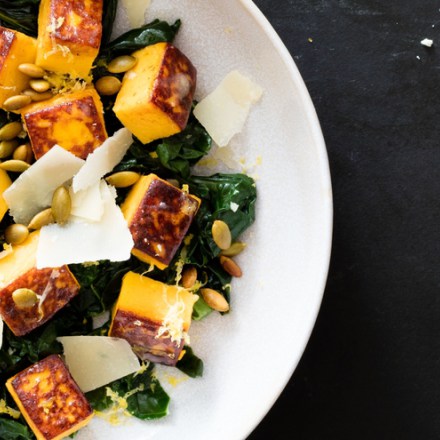Ingredients
Gnudi
| 1,200 g | butternut squash (1 large squash), peeled, halved, seeded, and sliced ¼ inch thick |
| 40 g | unsalted butter, cut into 4 pieces |
| 40 g | Parmesan cheese |
| 20 g | tapioca starch |
| 20 g | egg white powder |
| 4 g | kosher salt |
Kale
| 28 g | vegetable oil |
| 450 g | kale, stemmed and chopped |
| 30 g | water |
| 28 g | unsalted butter |
| 10 g | garlic cloves (2 cloves), minced |
| 5 g | sherry vinegar |
| Kosher salt and pepper |
| 40 g | unsalted butter |
| 4 g | fresh sage leaves, chopped fine |
| Kosher salt and pepper | |
| 20 g | roasted, salted pepitas |
| Finely grated lemon zest for serving | |
| Parmesan cheese, shaved with vegetable peeler, for serving | |
| Extra-virgin olive oil for serving |
Gnudi
| 2½ pounds butternut squash, peeled, halved, seeded, and sliced ¼ inch thick |
| 1½ ounces Parmesan cheese, grated fine (¾ cup) |
| 3 tablespoons plus 1 teaspoon egg white powder |
| 3 tablespoons unsalted butter, cut into 4 pieces |
| 2 tablespoons plus 2 teaspoons tapioca starch |
| 1 teaspoon kosher salt |
Kale
| 2 tablespoons vegetable oil |
| 1 pound kale, stemmed and chopped |
| 2 tablespoons water |
| 2 tablespoons unsalted butter |
| 2 garlic cloves, minced |
| 1 teaspoon sherry vinegar |
| Kosher salt and pepper |
| 3 tablespoons unsalted butter |
| 2 tablespoons fresh sage leaves, chopped fine |
| Kosher salt and pepper |
| 2 tablespoons roasted, salted pepitas |
| Finely grated lemon zest for serving |
| Parmesan cheese, shaved with vegetable peeler, for serving |
| Extra-virgin olive oil for serving |
Essential Equipment
Instructions
- 1,200 g butternut squash (1 large squash), peeled, halved, seeded, and sliced ¼ inch thick
- Meanwhile, adjust oven rack to middle position and heat oven to 300 degrees F/150 degrees C. Line bottom of large roasting pan with dish towel, folding towel to fit smoothly, and set aside. Spray 8-inch square baking pan with vegetable oil spray and line with plastic wrap, smoothing bottom with plastic bench scraper; set aside.
- 40 g unsalted butter, cut into 4 pieces
- 40 g Parmesan cheese, grated fine
- 20 g tapioca starch
- 20 g egg white powder
- 4 g kosher salt
- Cover baking pan tightly with aluminum foil and place in center of prepared roasting pan. Place roasting pan in oven and carefully pour 8 cups boiling water into roasting pan. Bake until center of mixture is set, no longer sticks to fingers when gently pressed, and registers 170 to 180 degrees F/77 to 82 degrees C, 1 hour to 1 hour 10 minutes. Remove baking pan from water bath, discard foil, and let cool slightly, about 10 minutes. Refrigerate gnudi in pan until firm, about 1 hour. (At this point gnudi can be wrapped in plastic wrap and refrigerated for up to 3 days.) Carefully unmold gnudi onto cutting board, discarding plastic. Using wet knife, cut gnudi into 1 by ¾-inch rectangular pieces, wiping knife with dish towel and rewetting between cuts. You will have 50 to 60 pieces.
- 28 g vegetable oil
- 450 g kale, stemmed and chopped
- 30 g water
- 28 g unsalted butter
- 10 g garlic cloves (2 cloves), minced
- 5 g sherry vinegar
- Kosher salt and pepper
- 40 g unsalted butter
- 4 g fresh sage, chopped fine
- Kosher salt and pepper
- 20 g roasted, salted pepitas
- Finely grated lemon zest for serving
- Parmesan cheese, shaved with vegetable peeler, for serving
- Extra-virgin olive oil for serving
Instructions
- 2½ pounds butternut squash, peeled, halved, seeded, and sliced ¼ inch thick
- Meanwhile, adjust oven rack to middle position and heat oven to 300 degrees F/150 degrees C. Line bottom of large roasting pan with dish towel, folding towel to fit smoothly, and set aside. Spray 8-inch square baking pan with vegetable oil spray and line with plastic wrap, smoothing bottom with plastic bench scraper; set aside.
- 1½ ounces Parmesan cheese, grated fine (¾ cup)
- 3 tablespoons plus 1 teaspoon egg white powder
- 3 tablespoons unsalted butter, cut into 4 pieces
- 2 tablespoons plus 2 teaspoons tapioca starch
- 1 teaspoon kosher salt
- Cover baking pan tightly with aluminum foil and place in center of prepared roasting pan. Place roasting pan in oven and carefully pour 8 cups boiling water into roasting pan. Bake until center of mixture is set, no longer sticks to fingers when gently pressed, and registers 170 to 180 degrees F/77 to 82 degrees C, 1 hour to 1 hour 10 minutes. Remove baking pan from water bath, discard foil, and let cool slightly, about 10 minutes. Refrigerate gnudi in pan until firm, about 1 hour. (At this point gnudi can be wrapped in plastic wrap and refrigerated for up to 3 days.) Carefully unmold gnudi onto cutting board, discarding plastic. Using wet knife, cut gnudi into 1 by ¾-inch rectangular pieces, wiping knife with dish towel and rewetting between cuts. You will have 50 to 60 pieces.
- 2 tablespoons vegetable oil
- 1 pound kale, stemmed and chopped
- 2 tablespoons water
- 2 tablespoons unsalted butter
- 2 garlic cloves, minced
- 1 teaspoon sherry vinegar
- Kosher salt and pepper
- 3 tablespoons unsalted butter
- 2 tablespoons fresh sage, chopped fine
- Kosher salt and pepper
- 2 tablespoons roasted, salted pepitas
- Finely grated lemon zest for serving
- Parmesan cheese, shaved with vegetable peeler, for serving
- Extra-virgin olive oil for serving
